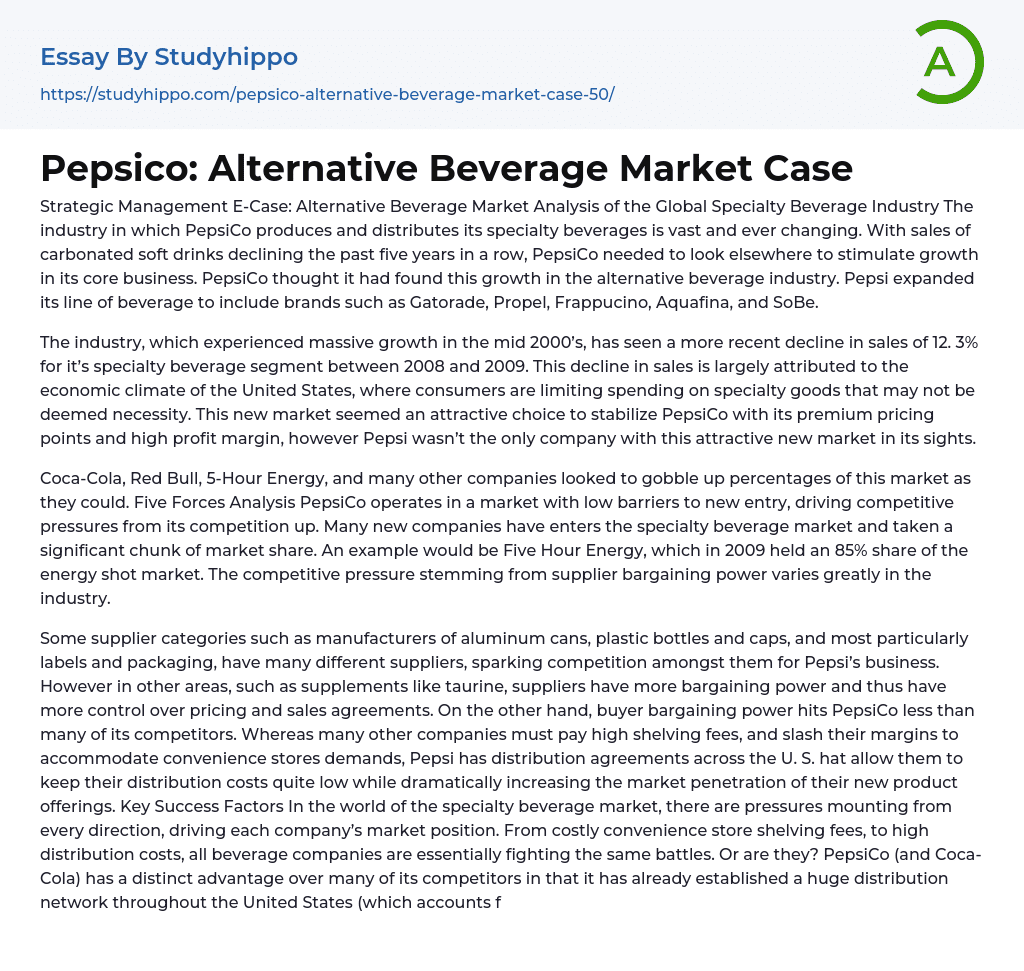Strategic Management E-Case: Global Specialty Beverage Industry Analysis
In the dynamic and constantly evolving specialty beverage industry, where PepsiCo operates, there has been a steady decrease in carbonated soft drink sales over the last five years. In order to address this trend, PepsiCo has actively pursued chances to broaden its primary business into other areas. Acknowledging the growth potential, PepsiCo strategically chose to enter the alternative beverage market by expanding its selection of beverages to encompass well-known brands such as Gatorade, Propel, Frappucino, Aquafina, and SoBe.
The specialty beverage segment of the industry experienced a significant rise in the mid 2000’s, but underwent a decline in sales of 12.3% from 2008 to 2009. This decrease in sales is mainly attributed to the economic situation of the United States, where consumers are reducing their expenditure on non-essential specialty products. P
...epsiCo identified this as a favorable chance to strengthen its position in the market due to increased prices and larger profit margins. However, PepsiCo was not the only company attracted to this profitable new market.
Coca-Cola, Red Bull, 5-Hour Energy, and various other companies sought to acquire portions of this market. PepsiCo operates in a market with easily accessible entry, which increases competition. Numerous new companies have entered the specialty beverage market and claimed a significant portion of market share. For instance, in 2009 Five Hour Energy held an 85% share of the energy shot market. The supplier bargaining power within the industry shows significant variation, thereby affecting competitive pressure.
In the beverage industry, Pepsi's business attracts intense competition and bargaining power among suppliers. Manufacturers of aluminum cans, plastic bottles and caps, labels, and packaging all compete for Pepsi's
attention. However, when it comes to supplements like taurine, suppliers have more control over pricing and sales agreements.
Compared to its competitors, PepsiCo faces less pressure from buyer bargaining power. While other companies must pay high shelving fees and lower their profit margins to meet convenience stores' demands, Pepsi benefits from distribution agreements across the U.S., which keep their distribution costs low and expand the reach of their new products.
A critical factor for success in the specialty beverage market is distribution. PepsiCo already possesses a significant advantage over its competitors with an established extensive distribution network throughout the United States that accounts for a large portion of the alternative beverage market. This enables Pepsi to ensure that its specialty beverages are available wherever its other Pepsi products are sold.
Product innovation plays a crucial role in achieving success in this market. It is vital for companies in this industry to differentiate their products from regular carbonated beverages; otherwise they will be competing with cheaper soft drinks and negatively impacting sales. Additionally, a company's image holds substantial importance in this industry.
Various factors, such as packaging, advertisements, celebrity and athlete endorsements, and event sponsorships, influence a consumer's perception of your product. Hence, it is crucial for us to shape the desired image among our consumers. Branding plays a significant role in achieving success in this industry. Pepsi has an advantage over its lesser-known competitors in this area and has successfully developed numerous successful brands.
In this industry, there are strategic groups of companies including PepsiCo and Coca-Cola.
Both companies have similar product ranges and distribution strategies, resulting in direct competition due to their comparable capabilities. Furthermore, there is another strategic group
composed of Five Hour Energy, Rockstar, Red Bull, and Monster Energy that concentrates exclusively on catering to the niche market of energy drinks. This group abstains from competing in other beverage categories such as sodas, vitamin waters, teas, or juices. After conducting extensive research, I have come to the following conclusion regarding the long-term attractiveness of this industry.
PepsiCo has greatly profited from its established distribution network, making the industry highly lucrative. Analysts anticipate that the specialty beverage market in the United States will grow to $23.6 billion in 2014, compared to $19 billion in 2009. This projection suggests that despite an initial decline due to economic factors, there will be a positive trend in the upcoming years as consumers regain their purchasing power. Given the growing number of health-conscious Americans, it is clear that Pepsi cannot rely solely on carbonated drink sales indefinitely.
In order to capitalize on the emerging specialty health markets, Pepsi needs to adapt and act swiftly. Additionally, it should strategically eliminate its distribution agreement with Monster and other competitors in the energy drink market to gain a competitive edge through its superior distribution network. Given the current trends, the specialty beverage market appears to hold great potential for the future of bottled beverages. Therefore, Pepsi should closely monitor market movements going forward to maintain a competitive advantage over its rivals.
- Beef essays
- Beer essays
- Beverages essays
- Bread essays
- Burger essays
- Cake essays
- Coconut essays
- Coffee essays
- Cooking essays
- Crowd essays
- Cuisines essays
- Dairy essays
- Desserts essays
- Dinner essays
- Drink essays
- Fast Food essays
- Favorite Food essays
- Food Safety essays
- Food Security essays
- Food Waste essays
- Fruit essays
- Ginger essays
- Hamburger essays
- Ice Cream essays
- Juice essays
- Lemon essays
- Meal essays
- Meat essays
- Oreo essays
- Organic Food essays
- Pizza essays
- Rice essays
- Sainsbury essays
- Sugar essays
- Taste essays
- Tea essays
- Wine essays
- Adidas essays
- Amazon essays
- Apple essays
- Bmw essays
- British Airways essays
- Burger King essays
- Coca-Cola essays
- Company essays
- Costco essays
- Dell essays
- Ebay essays
- Enron essays
- Facebook essays




